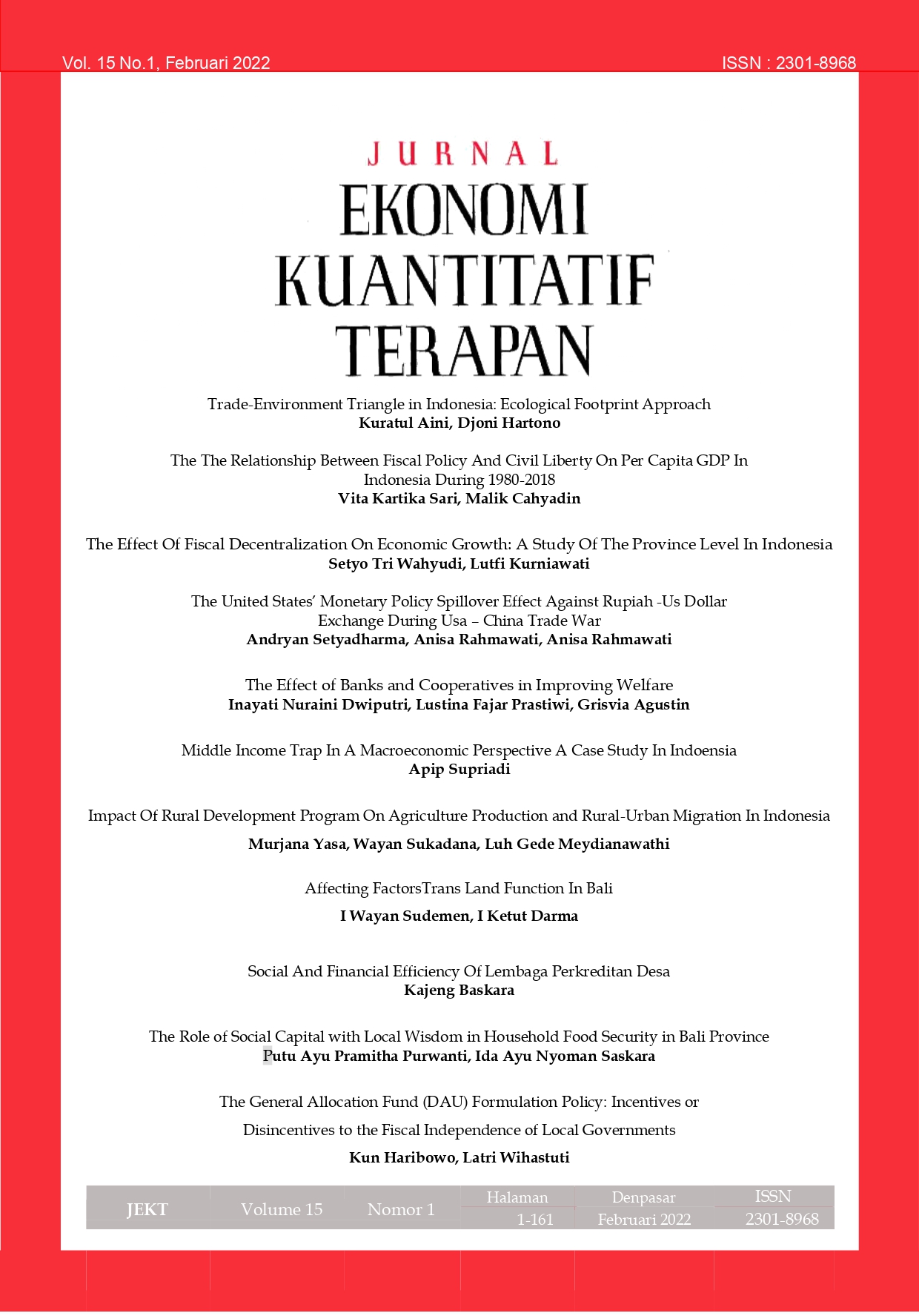The Relationship between Fiscal Policy and Civil Liberty on Per capita GDP in Indonesia during 1980-2018
-
Abstract
ABSTRACT
Fiscal policy has a contribution to community welfare. Many empirical findings explained the relationship between the fiscal component and per capita income. In addition, civil liberty is a driving factor in economic life. Thus, this study estimated the relationship between fiscal policy and civil liberty on Per capita GDP in Indonesia during 1980-2018. The VAR and Bayesian VAR estimation models were selected and relevant to the a-theoretic economic variables. The empirical findings showed that the tax ratio contributed significantly to inhibit the increase in Per capita GDP, barriers to parties resulted in damaging Per capita GDP, but access to justice improved Per capita GDP. Thus, the Indonesian government should be able to encourage fiscal allocations for strategic and productive programs. In addition, the Indonesian government should also protect and guarantee civil liberties in accordance with applicable laws and regulations.
Key words: government expenditure, tax ratio, external debt, civil liberty, Per capita GDP
JEL Classification: E01, E02, E62, H63
Downloads
References
Amir-ud-Din, Rafi and Rana Ejaz Ali Khan. 2017. Democracy, Income Inequality and Economic Growth Nexus: The Case of Pakistan. Pakistan Journal of Commerce and Social Sciences 2017, Vol. 11 (1), 205-220.
Arin, K. Peren, Elias Braunfels and Gernot Doppelhofer. 2019. Revisiting the growth effects of fiscal policy: A Bayesian model averaging approach. Journal of Macroeconomics. 62, pp. 1-16. doi:10.1016/j.jmacro.2019.103158
Attinasi, Maria Grazia and Alexander Klemm. 2016. The growth impact of discretionary fiscal policy measures. Journal of Macroeconomics. 49, pp. 265–279. doi:10.1016/j.jmacro.2016.08.004
Baldacci, E., A.L. Hillman, and N.C. Kojo. 2004. Growth, Governance, and Fiscal Policy Transmission Channels In Low-Income Countries. European Journal of Political Economy, Vol. 20 No. 3, pp. 517-549.
Barro, R.J. 1990. Government Spending In A Simple Model Of Endogenous Growth. J. Polit. Economy 59 (4), S103–S125.
Bozkurt, Eda, Ali Altiner, and Yılmaz Toktaş. 2018. Democracy and economic growth: evidence from emerging market economies. Economics, Finance and Politics Volume 13/14, Spring 2018, p. 15-32 DOI: http://dx.doi.org/10.7827/TurkishStudies.13477.
Canh, Nguyen Phuc. 2018. The effectiveness of fiscal policy: contributions from institutions and external debts. Journal of Asian Business and Economic Studies. Vol. 25, No. 1, pp. 50-66.DOI 10.1108/JABES-05-2018-0009
Doucouliagos, Hristos and Ulubaşoğlu, Mehmet Ali. 2008. Democracy and Economic Growth: A Meta-Analysis. American Journal of Political Science , Jan., 2008, Vol. 52, No. 1 (Jan., 2008), pp. 61-83.
Drury, Cooper, Jonathan Krieckhaus, and Michael Lusztig. 2006. Corruption, Democracy, and Economic Growth. International Political Science Review (2006), Vol 27, No. 2, 121–136.
Dweck, Esther, Matheus Trotta Vianna and Arthur da Cruz Barbosa. 2019. Discussing the role of fiscal policy in a demand-led agent-based growth model. EconomiA. Pp. 1-20. doi:10.1016/j.econ.2019.03.004
Gujarati, D.N. 2003. Basic Econometrics. Fourth Edition. New York: McGraw-Hill.
Knutsen, Carl Henrik. 2012. Democracy and Economic Growth: A Survey of Arguments and Results. International Area Studies Review, December 2012 DOI: 10.1177/2233865912455268.
Maipita, Indra, Mohd. Dan Jantan, and Nor Azam Abdul Razak. (2010). The Impact Of Fiscal Policy Toward Economic Performance And Poverty Rate In Indonesia. Bulletin of Monetary, Economics and Banking, Vol. 12, No. 4, pp. 391-424. https://doi.org/10.21098/bemp.v12i4.378
Martinez-Vazquez, J. et al. 2007. Corruption, Fiscal Policy, And Fiscal Management. J. (Eds), Fighting Corruption in the Public Sector, pp. 1-10. Emerald Group Publishing Limited.
Mencinger, Jernej, Aleksander Aristovnik, and Miroslav Verbič. 2017. Asymmetric effects of fiscal policy in EU and OECD countries. Economic Modelling. 61, pp. 448–461. doi:10.1016/j.econmod.2016.12.023
Miranda-Agrippino, Silvia and Giovanni Ricco. 2018. Bayesian Vector Autoregressions. Oxford Encyclopedia of Economics and Finance, pp. 1-60. http://economics.oxfordre.com.
Narayan, Paresh Khumar and Russell Smith. 2006. Democracy and Economic Growth In China: Evidence From Cointegration And Causality Testing. Review of Applied Economics, Vol. 2 No.1, pp. 81-98.
Piatek, Dawid, Katarzyna Szarzec and Michał Pilc. 2013. Economic freedom, democracy and economic growth: a causal investigation in transition countries. Post-Communist Economies. Vol. 25, No. 3, pp. 267–288. http://dx.doi.org/10.1080/14631377.2013.813137.
Plümper, Thomas and Christian W. Martin. 2003. Democracy, government spending, and economic growth: A political-economic explanation of the Barro-effect. Public Choice. 117, pp. 27–50.
Rock, Michael T. 2017. Indonesia’s Centripetal Democracy and Economic Growth. Journal of Asia Pacific Economy, 23.1: 156-172.
Rosser, Andrew and Ian Wilson. 2012. Democratic Decentralisation and Pro-poor Policy Reform in Indonesia: The Politics of Health Insurance for the Poor in Jembrana and Tabanan. Asian Journal of Social Science , 2012, Vol. 40, No. 5/6, pp. 608-634.
Sayari, Naz, Ramazan Sari and Shawkat Hammoudeh. 2018. The impact of value added components of GDP and FDI on economic freedom in Europe. Economic Systems, 42(2), pp. 282–294. doi:10.1016/j.ecosys.2017.03.003
Shepherd, Edward 2018. Liberty, property and the state: The ideology of the institution of English town and country planning. Progress in Planning. pp. 1-37. doi:10.1016/j.progress.2018.09.001
Solow, Robert M. 1956. A Contribution to the Theory of Economic Growth. The Quarterly Journal of Economics, Vol. 70, No. 1, pp. 65-94.
Tavares, Jose and Romain Wacziarg. 2001. How Democracy Afects Growth. European Economic Review, 45, pp. 1341-1378.
Thanh, Su Dinh, Neil Hart and Nguyen Phuc Canh. 2020. Public spending, public governance and economic growth at the Vietnamese provincial level: A disaggregate analysis. Economic Systems, pp. 1-20. doi:10.1016/j.ecosys.2020.100780
Winters, Jeffrey A. 2013. Oligarchy and Democracy in Indonesia. Wealth, Power, and Contemporary Indonesian Politics, No. 96, pp. 11-33. DOI: 10.5728/indonesia.96.0099.
Youni, Muhammad, et al. 2008. Political Stability and Economic Growth in Asia. American Journal of Applied Sciences, 5 (3), pp. 203-208, 2008.




















